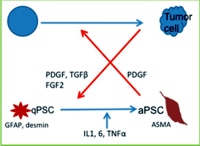Screening and Detection of Pancreatic Cancer
Abstract
Screening and early detection of pancreatic cancer has the potential to substantially impact outcomes in this deadly disease. Over the last ten years several cohort studies have been conducted and report on the yield of screening in high risk populations. With better understanding of the cellular compartments and the genetic and epigenetic changes that occur, biomarkers have also emerged as promising means of early detection. In this paper we summarize the results of the latest screening cohort and highlight a novel proteomic approach that may be used in future biomarker studies.
Image: Factors responsible for the activation of pancreatic stellate cells.
Downloads
References
Raimondi S, Maisonneuve P, Lowenfels AB. Epidemiology of pancreatic cancer: an overview. Nat Rev Gastroenterol Hepatol 2009; 6(12):699-708.
Maisonneuve P, Lowenfels AB. Epidemiology of pancreatic cancer: an update. Dig Dis 2010; 28(4-5):645-656.
Brand RE, Lerch MM, Rubinstein WS, et al. Advances in counselling and surveillance of patients at risk for pancreatic cancer. Gut 2007; 56(10):1460-1469.
Grover S, Syngal S. Hereditary pancreatic cancer. Gastroenterology 2010; 139(4):1076-1080, 1080 e1071-1072.
Gonda TA, Tu S, Wang TC. Chronic inflammation, the tumor microenvironment and carcinogenesis. Cell Cycle 2009; 8(13):2005-2013.
Al-Sukhni W, Borgida A, Rothenmund H, Holter S, Wilson S, Moore MJ, et al. Screening for pancreatic cancer in a high-risk cohort: A 7-year experience. J Clin Oncol 2011; 29(Suppl.):4045.
Amundadottir LT, Thorvaldsson S, Gudbjartsson DF, et al. Cancer as a complex phenotype: pattern of cancer distribution within and beyond the nuclear family. PLoS Med 2004; 1(3):e65.
Klein AP, Brune KA, Petersen GM, et al. Prospective risk of pancreatic cancer in familial pancreatic cancer kindreds. Cancer Res 2004; 64(7):2634-2638.
Larghi A, Verna EC, Lecca PG, Costamagna G. Screening for pancreatic cancer in high-risk individuals: a call for endoscopic ultrasound. Clin Cancer Res 2009; 15(6):1907-1914.
Wehr AY, Blair IA, Yu KH Tumor microenvironment derived biomarkers for the early detection of pancreatic cancer (PDAC). J Clin Oncol 2011; 29(Suppl.):e14591.
Gonda TA, Varro A, Wang TC, Tycko B. Molecular biology of cancer-associated fibroblasts: can these cells be targeted in anti-cancer therapy? Semin Cell Dev Biol 2010; 21(1):2-10.
Masanume A, Watanabe T, Kikuta K et al. Roles of pancreatic stellate cells in pancreatic inflammation and fibrosis. Clin Gastro Hepatology 2009; 7:S48-S54.
Wehr AY, Furth EE, Sangar V, Blair IA, Yu KH. Analysis of the human pancreatic stellate cell secreted proteome. Pancreas 2011; 40(4):557-566.
Everley PA, Krijgsveld J, Zetter BR, Gygi SP. Quantitative cancer proteomics: stable isotope labeling with amino acids in cell culture (SILAC) as a tool for prostate cancer research. Mol Cell Proteomics 2004; 3(7):729-735.
Ong SE, Blagoev B, Kratchmarova I, et al. Stable isotope labeling by amino acids in cell culture, SILAC, as a simple and accurate approach to expression proteomics. Mol Cell Proteomics 2002; 1(5):376-386.
Makawita S, Diamandis EP. The bottleneck in the cancer biomarker pipeline and protein quantification through mass spectrometry-based approaches: current strategies for candidate verification. Clin Chem 2010; 56(2):212-222.
Brentnall TA, Bronner MP, Byrd DR, Haggitt RC, Kimmey MB. Early diagnosis and treatment of pancreatic dysplasia in patients with a family history of pancreatic cancer. Ann Intern Med 1999; 131:247-55.
Canto MI, Goggins M, Yeo CJ, et al. Screening for pancreatic neoplasia in high-risk individuals: an EUS-based approach. Clin Gastroenterol Hepatol. Jul 2004; 2(7):606-621.
Langer P, Kann PH, Fendrich V, et al. Five years of prospective screening of high-risk individuals from families with familial pancreatic cancer. Gut 2009; 58(10):1410-1418.
Verna EC, Hwang C, Stevens PD, et al. Pancreatic cancer screening in a prospective cohort of high-risk patients: a comprehensive strategy of imaging and genetics. Clin Cancer Res 2010; 16(20):5028-5037.
Ludwig E, Olson SH, Bayuga S, Simon J, Schattner MA, Gerdes H, et al. Feasibility and yield of screening in relatives from familial pancreatic cancer families. Am J Gastroenterol 2011; 106:946-54.

Copyright (c) 2011 Tamas A Gonda, Aimee Lucas, Muhammad Wasif Saif

This work is licensed under a Creative Commons Attribution 4.0 International License.
As a member of Publisher International Linking Association, PILA, iMedPub Group’s JOP follows the Creative Commons Attribution License and Scholars Open Access publishing policies. Journal of the Pancreas is the Council Contributor Member of Council of Science Editors (CSE) and following the CSE slogan Education, Ethics, and Evidence for Editors.